Last Saturday’s EFL League One matchday saw play-off chasing Oxford United draw 1-1 at Fratton Park with Portsmouth. Karl Robinson’s Oxford would have been hoping for all three points heading into the tie, however, were forced to settle for a point against Kenny Jackett’s resilient Pompey. The stalemate left Oxford in fifth place and the home side in 15th.
This tactical analysis will dissect the key tactics of both sides and use analysis to highlight how those set-ups influenced the eventual outcome of the clash.
Lineups

Jackett stuck with his trusted 4-2-3-1 formation for the game with Oxford, having deviated from the set-up on very few occasions this season. Although favouring the 4-2-3-1, the Englishman has also deployed a 4-4-2 sporadically. In terms of personnel changes, Jackett made no alterations to his side’s starting lineup following their 2-2 away draw to Bristol Rovers last time out.
United deployed a 4-3-1-2 for their trip to Fratton Park, a system which Robinson has rarely used whilst at the helm at the Kassam Stadium. Robinson’s most used formation so far this term has been a 4-3-3, having also used a 4-2-3-1 and a 4-5-1 on a couple of occasions. Aside from the change in structure, Oxford also made three changes to their starting lineup. Elliott Moore, Shandon Baptiste and Robert Hall were replaced by John Mousinho, Mark Sykes and Jamie Mackie – presumably to facilitate the change in tactical shape.
Portsmouth’s high and wide full-backs
As a constant throughout the game, Pompey had their full-backs push high and wide where possible to support attacking moves. While it was rare that both would attack at the same time, they would both often be positioned, ready to attack when their side was in possession. Having the extra man in attack from full-back assisted Jackett’s side in creating overloads in the U’s third and provided support to the winger ahead of them.
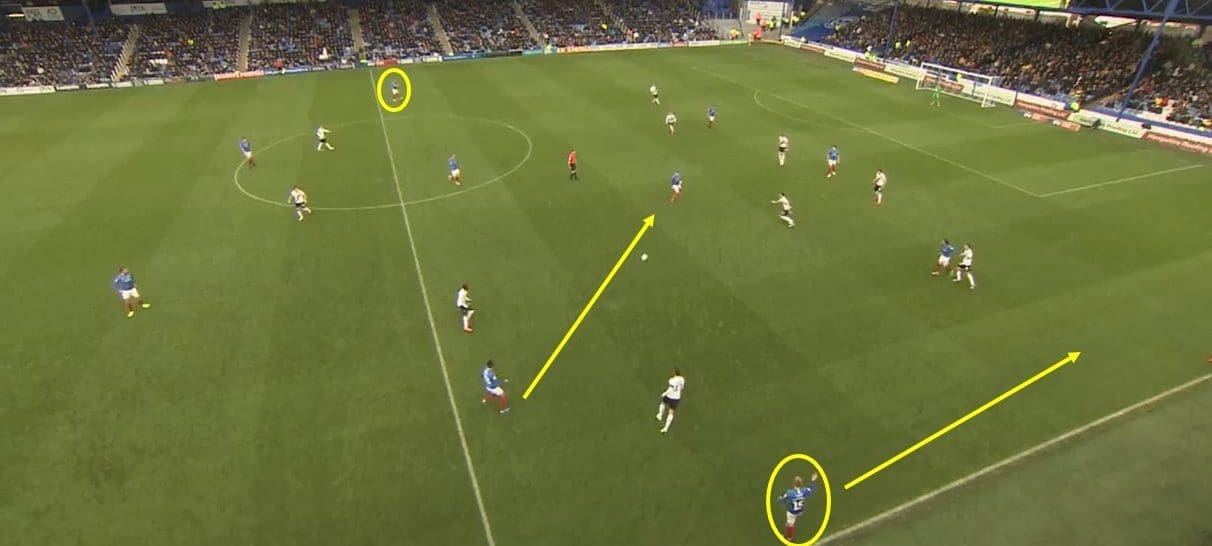
Here, it can be seen how both of Portsmouth’s full-backs – Ross McCrorie and Lee Brown – are in a position to attack the wide areas after the ball has been played inside. Should the midfielder go left, then Brown would attack, and should he go right, then McCrorie would. In this instance, McCrorie can be seen pointing down the right-hand side as he anticipates the ball to be played down his side and senses the opportunity.
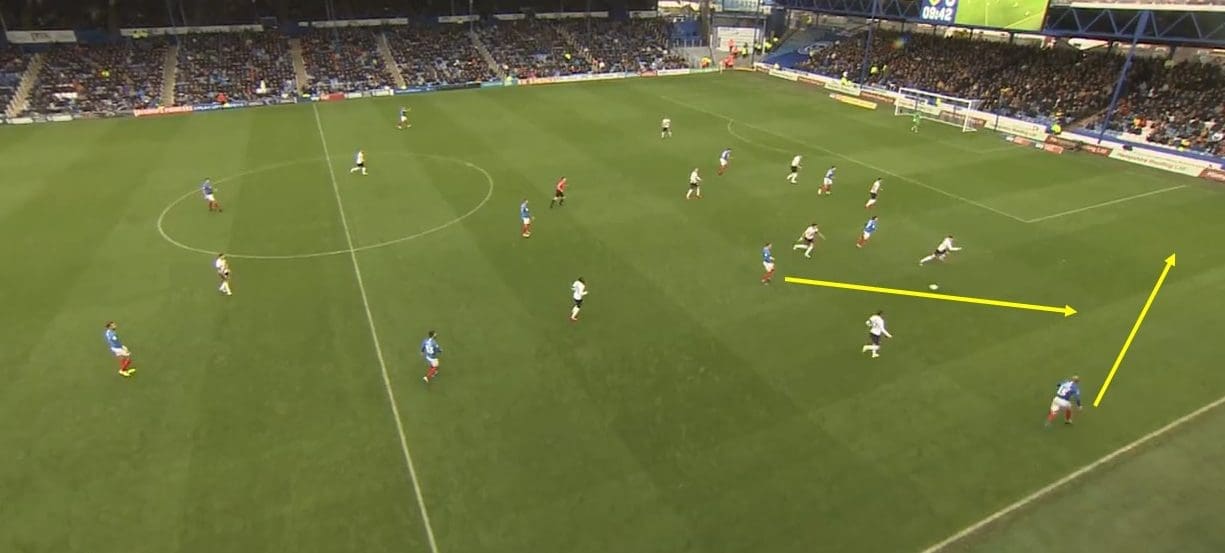
With the midfielder having chosen to go towards the right-hand side McCrorie makes a darting run forward. Due to the pace of the right-sided full-back and the through pass, McCrorie has a high chance of being able to get in behind the full-back opposite him for Oxford. In this instance, however, Josh Ruffles was able to recover the ball.
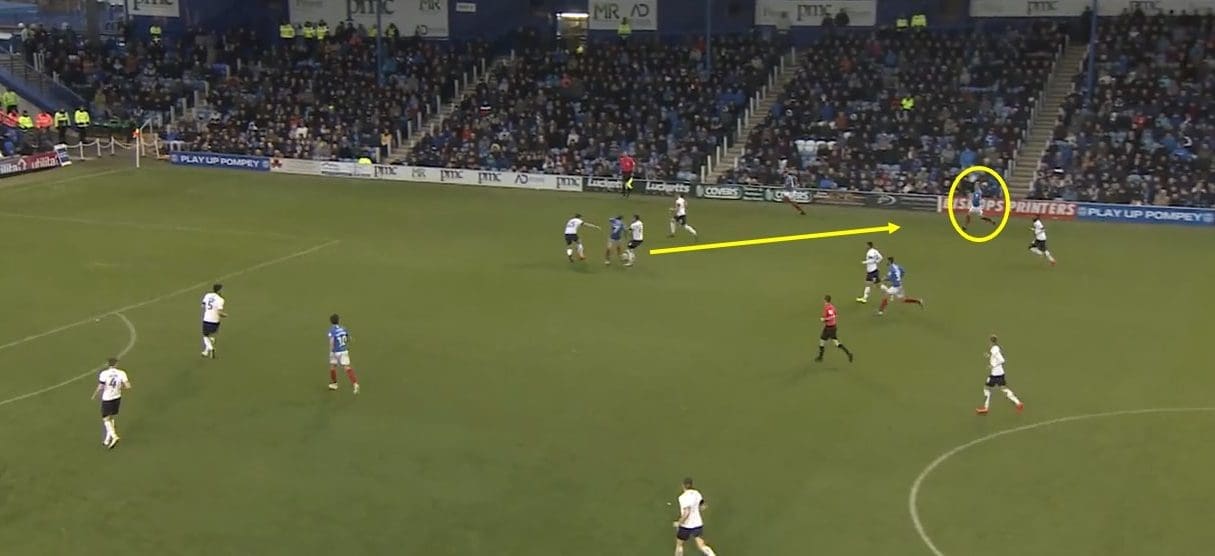
As can be seen in the above annotation, taken from the build-up to Portsmouth winning the penalty which opened the afternoon’s scoring, McCrorie is again high up the pitch. With Jackett’s side advancing in numbers, McCrorie has joined the attack and is positioned in a good area – between Oxford’s midfield and defensive thirds. With Ryan Williams being pressured by the U’s defenders, McCrorie is in position to receive a pass and with a first-time through ball finds John Marquis, who plays a first-time pass into Gareth Evans – who is then brought down in the penalty area.
Robinson’s switch to a 4-3-1-2
The 4-3-1-2 that was deployed by Robinson on Saturday is a structure that has not been on show for the Kassam Stadium club much this term. The U’s switch from the 4-3-3 last time out will, most likely, have been to counter Portsmouth’s reliance with attacking full-backs in the wide area. While Pompy attacked wide, Oxford looked to control the centre areas of the pitch with their narrowly structured shape.
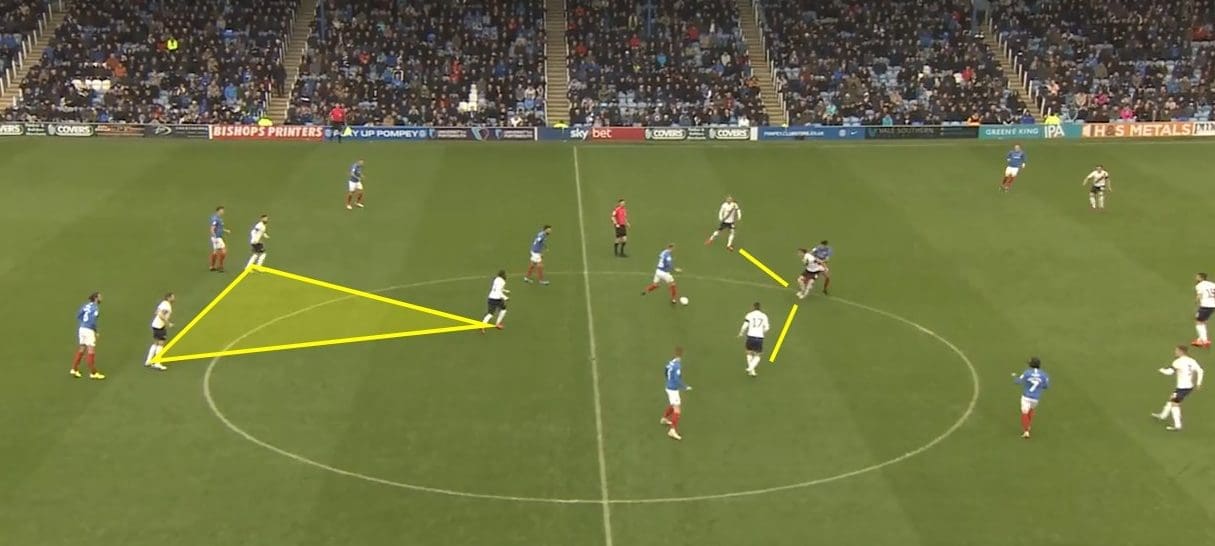
As can be seen in the above annotation, Oxford’s narrow midfield and attacking trios have been highlighted. With the midfield three playing narrow – to control the play in the centre of the pitch – Tariqe Fosu plays in a classic number ten role just ahead of them. Fosu’s main job being to connect the middle and attacking thirds of the pitch.

The U’s pass map further highlights this dominance in the middle of the Fratton Park pitch. This shows how compact the midfield and attacking players were for Robinson, with only defenders having long average passing lines. This calculated switch to a 4-3-1-2 from Robinson made life difficult for Pompey to play through the centre of the pitch due to the sheer number of Oxford players stationed there.
Pompey’s lofted balls down the wings
Due to the number of players Oxford had in the centre of the park, Portsmouth resorted to long, lofted passes in the wide areas of the pitch to move the ball straight from the defensive line to the attacking one. With Robinson’s side playing narrow, Pompey opted for the wide areas in the majority as that was where the opportunity was often presented. This tactic, ultimately, resulted in the game becoming somewhat of a longball affair.
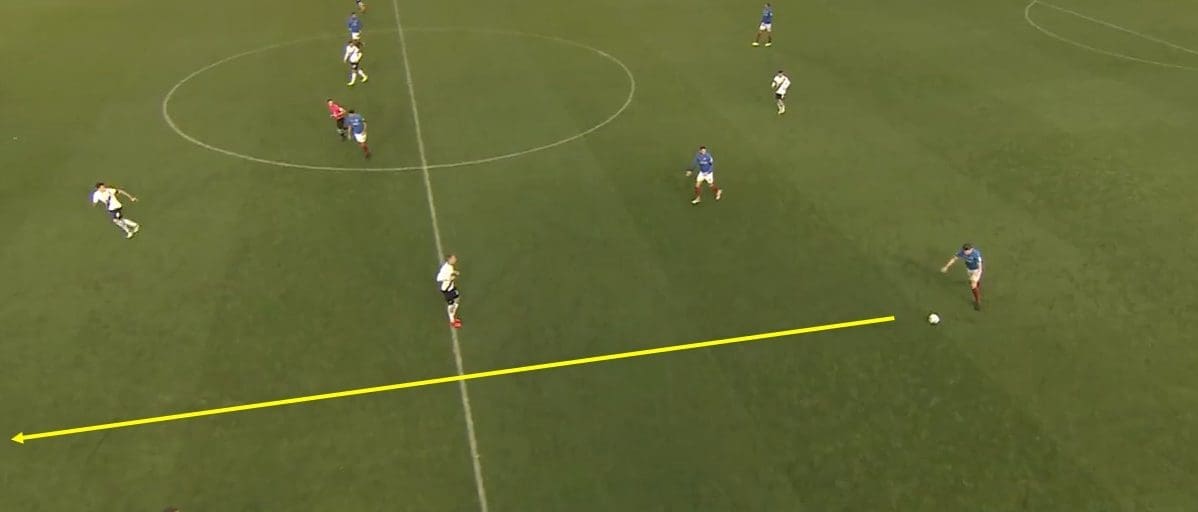
Here, a key example of Portsmouth moving the ball forward in the wide area and quickly has been highlighted. Despite having several infield options available to the Portsmouth defender, he instead opts to punt the ball long, down the line, to move quickly up the pitch. His pass is marked by the yellow arrow and in this instance, the ball drops behind Oxford’s defensive line but goes out for a Simon Eastwood goal kick.

As can be seen here, Pompey’s pass map from the game highlights this long ball in the wide-area tactic further. Right across Jackett’s defensive line, the most frequent pass is a long ball forward to the attacking line, either that or the centre-backs playing the ball to the full-backs to play a long ball forward. This tactic was born from Oxford controlling the centre of the pitch and, although having the best of the chances, limited Portsmouth in their ability to control the ball – resulting in a low percentage of possession for Jackett’s side, 43%, and a low pass accuracy, 56%.
Oxford’s fast switch from defence to attack
Robinson’s narrow structure also lent itself to being relatively solid at the back, whilst then being able to quickly launch an attack with a high volume of numbers. While United found shots at goal hard to come by – mustering only one on target throughout the whole match – their structure did allow them to control possession more easily than Portsmouth found it, with 57%.
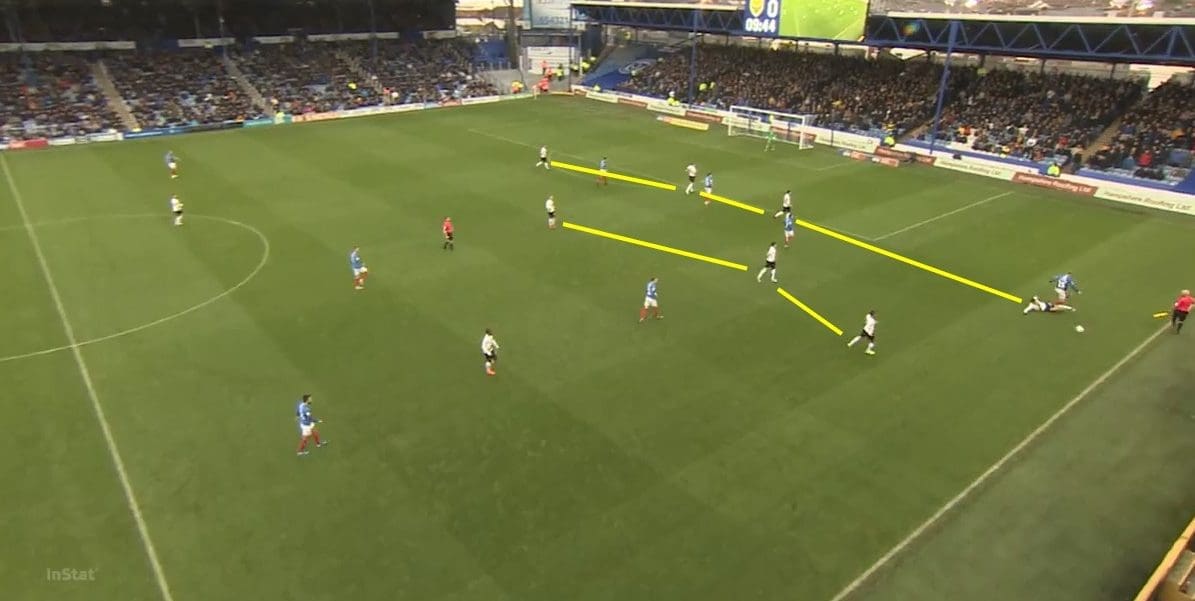
Here, it can be seen how deep Oxford’s midfield and defensive lines were sitting to frustrate Portsmouth’s forward line and restrict the home side’s quality of chances. Notice, also, how little room there is for Pompey’s attackers to operate between the lines of defence and midfield due to how compact the two are.
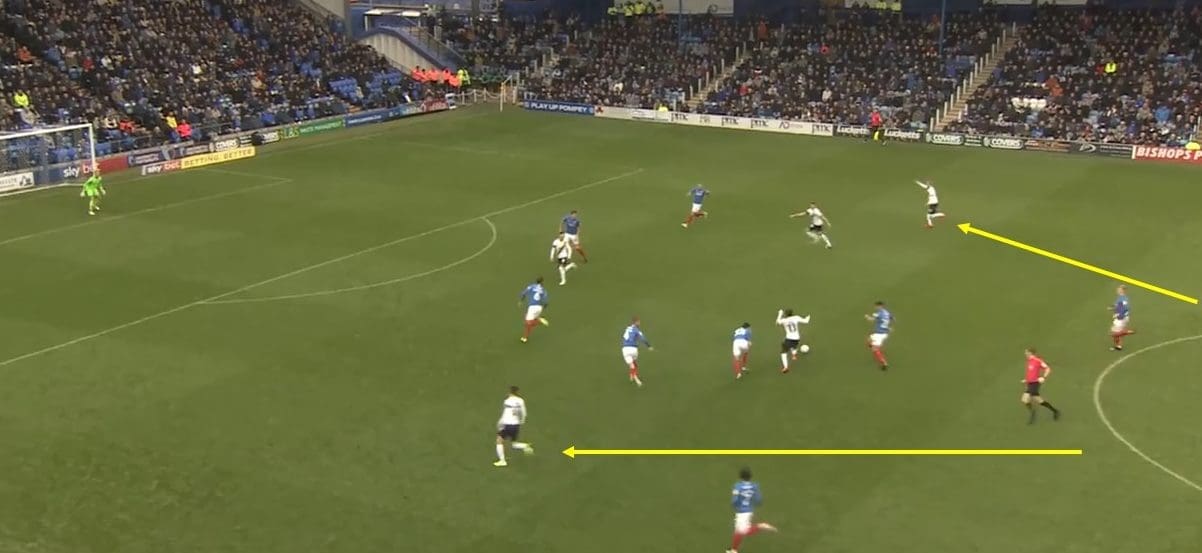
Then, as highlighted by a different instance from the match, when possession would be turned back over to Oxford, they would be able to attack in numbers. Due to the strength and pace of Fosu, when the ball was played into the area of the number ten, forward runs could be made ahead of him to overload Pompey’s backline. When Fosu received the ball, Sykes and James Henry – the right and left side of the midfield three – could move outwards from behind Fosu to create passing options in the wide areas. Oxford’s 4-3-1-2 made this possible, allowing Robinson’s side to retain solidarity at the back and break quickly in numbers when the opportunity arose.
Conclusion
Heading into the tie, Jackett would probably have been the happier of the two managers had he known his side would be coming out with a point. However, after having watched the two sides frustrate one another on a blustery afternoon at Fratton Park – both will have been willing to settle for a point despite the gulf between the two in the League One table. Although the late equaliser for Oxford will have been a frustrating one for Pompey, on the face of it a draw was a fair result.
This tactical analysis has discussed the tactics used by both Portsmouth and Oxford in their League One clash and use analysis to show how their set-ups led to the match’s outcome.

If you love tactical analysis, then you’ll love the digital magazines from totalfootballanalysis.com – a guaranteed 100+ pages of pure tactical analysis covering topics from the Premier League, Serie A, La Liga, Bundesliga and many, many more. Buy your copy of the October issue for just ₤4.99 here





Comments